Global Positioning Satellites
In June of 1993 the last of the 24 satellites of the Global Positioning System was placed into orbit, completing a satellite network capable providing position data to locate you anywhere on Earth within 30 meters. The satellites carry up to four cesium and rubidium atomic clockswhich are periodically updated from a ground station in Colorado.
The satellites transmit timing signals and position data. A GPS receiver, which can be a small, hand-held device, decodes the timing signals from several of the satellites, interpreting the arrival times in terms of latitude, longitude, and altitute with an uncertainty which may be as small as 10 meters. In differential mode, accuracies of less than a centimeter can be obtained for distances of hundreds of kilometers.
Hand-held units read out longitude and latitude to a thousandth of an arcminute and change in the last decimal place in a couple of paces while walking. The satellites are in orbitsmuch lower than the syncom satellites, orbiting around 17.7 million meters (11000 mi) above the earth, with orbit periods on the order of 10 hours.
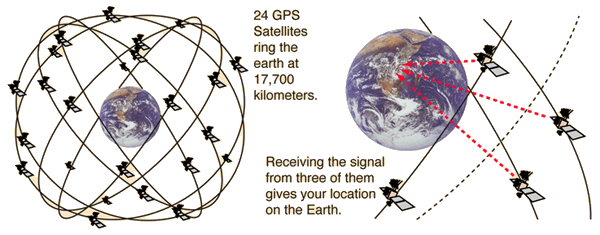
From aircraft and ship navigation to finding the favorite fishing hole on the lake, the applications of GPS have multiplied rapidly.
Global Positioning Orbits
The 24 satellites of the GPS are placed in orbits at about 3.75 times the radius of the Earth. A GPS receiver, which may be a small hand-held unit, can triangulate its position on the Earth's surface within 30 meters or less with signals from three of the satellites. The satellites are arranged in six orbital planes with four satellites in each plane.
| 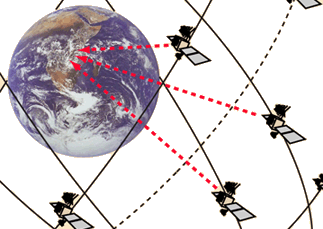 |

GPS Navigation Message
The positioning information from GPS satellites in sent in the form of repeating codes which identify the sending satellite, give locations of the other satellites in the system, and give the navigation data. The codes which form the GPS signal structure are superimposed upon two carrier waves in the L-band , a frequency range set aside for satellite communication.
Both the carrier frequencies and the signal frequencies are derived directly from the onboard atomic clock oscillator frequency of 10.23 MHz. The coded signals are repeated regularly in epochs on the order of 15 seconds. The codes used are referred to as "pseudo-random codes", a name applied by early radio astronomers who were the first to make wide use of such codes.
The codes are well suited to decoding a message embedded in noise signals which may be orders of magnitude larger than the signal itself. Such techniques were valuable in picking up radar echoes off the moon and asteroids. Use of these codes facilitates the sorting out of signals which arrive simultaneously from several GPS satellites.
Global Positioning Triangulation
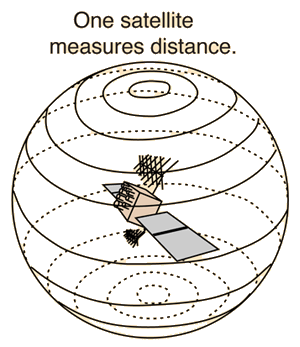 | A single satellite can establish range, locating the detector on a sphere.Two satellites can locate the detector on the intersection of two spheres.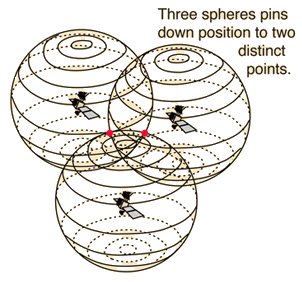 |
 |
Adding a third as in the GPS system locates it at one of two discrete points where the three spheres intersect. The correct one is easily chosen to get a precise location. The 24 GPS satellites carry atomic clocks to give them the accuracy necessary for position measurement.
|
Very accurate clocks can be constructed by locking an electronic oscillator to the frequency of an atomic transition. The frequencies associated with such transitions are so reproducible that the definition of the second is now tied to the frequency associated with a transition in cesium-133:
The two most widely used atomic clocks in recent years have been the cesium beam atomic clock and the rubidium clock. Such clocks have provided the accuracy necessary to test general relativity and to track variations in the frequencies of pulsars. Atomic clocks are integral parts of the Global Positioning System since extreme accuracy in timing is necessary for the triangulation involved.
The current time standard for the United States is a cesium atomic frequency standard at the National Institute of Standards and Technology in Boulder, Colorado. In 1967 a standard second was adopted based on the frequency of a transition in the Cs-133 atom:
Prior to 1964 the international standard second had been based upon the orbital period of the Earth, but the cesium clock period was found to be much more stable than the Earth's orbit! The SI unit of time, the second, is now defined by this transition in cesium.
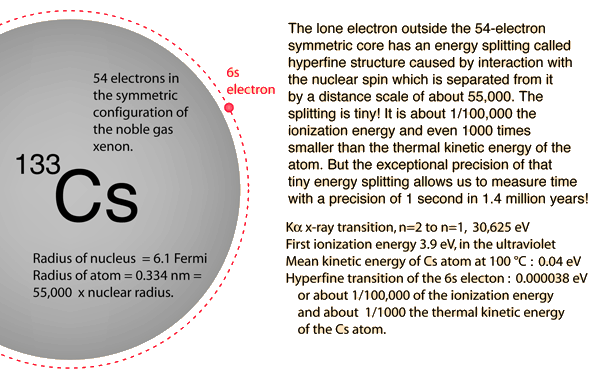

The frequency of this atomic clock is in the microwave region of the electromagnetic spectrum and is a convenient one for locking a microwave oscillator. Cesium clocks have demonstrated stability to 2 parts in 1014, or one second in 1,400,000 years according to the Naval Observatory source cited below.
Set your watch by it: (303) 499-7111 . Time signals based on it are available by short wave radio (WWV and WWVH).
To understand how remarkable the cesium atom is as a basis for the cesium atomic clock, it is necessary to examine the details of the structure of this atom. Having 55 protons in its nucleus, it must have 55 electrons in orbit around that nucleus to be a neutral atom. The electron states are described by four quantum numbers, and those of cesium fill all the electron states that are part of the noble gas xenon (54 electrons) and then there is just one additional electron outside that symmetric electron distribution. Following the order of filling of the electron shells, the xenon structure fills all the levels up through the 5p electrons. The next available energy level is the 6s electron, so the chemistry of cesium is determined by that lone 6s electron.
It is typical for the quantum energy state of such a valence electron to be split by fine structure arising from the magnetic interaction of the electron spin with the orbital angular momentum of the inner electrons. But the inner core of the electrons of cesium is perfectly symmetrical and has zero angular momentum, so there is no fine structure.
However, the cesium nucleus exhibits a magnetic influence associated with the nuclear spin, which has the large value 7/2. Though quantum mechanical in nature, the interaction can be visualized as the interaction between two magnets - that of the nucleus and that of the electron, and there are two very closely spaced energy levels for the 6s electron based on whether the nuclear and electron spins are parallel or antiparallel. This splitting is called "hyperfine structure". It is this pair of precise and closely spaced energy levels that makes possible the cesium clock mechanism.
One remarkable aspect of the interaction which makes possible the cesium clock is the vast separation, relatively speaking, between the nuclear spin and the electron spin with which it interacts. The nuclear radius for a nucleus of mass number A=133 is 6.1 x 10-15 meters or 6.1 Fermis. The radius of the cesium atom where the 6s electron resides can be found from the periodic table to be 3.34 x 10-10 meters or 0.334 nm, almost 55,000 times as large!
Another remarkable comparison is that of the energy levels involved. The 6s valence electron can be ejected from the atom by an ultraviolet photon of quantum energy 3.9 electron volts. By comparison, the pair of hyperfine levels involved in the cesium clock are separated by only 0.000038 eV, about 100,000 times smaller. This energy is in the microwave region, and is about a thousand times smaller than the random thermal energy of about 0.04 eV associated with the 100 °C temperature at which the cesium clock is typically operated.
The two most commonly used atomic clocks in recent years have been the cesium clock and the rubidium clock. Both involve the locking of an electronic oscillator to the atomic transition. The rubidium clock has had the advantage of portability, achieving an accuracy of about 1 in 10^12 in a transportable instrument. This has made it useful for carrying from one cesium clock to another to synchronize the clocks.
Earth Orbit Velocity
The velocity of a satellite in circular orbit around the Earth depends upon the radius of the orbit and the acceleration of gravity at the orbit.
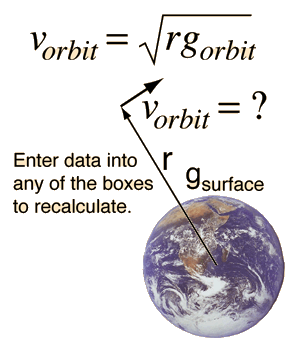 |
Syncom Satellites
Communication satellites are most valuable when they stay above the same point on the earth, in what are called "geostationary orbits". This occurs when the orbital period is 24 hours. From an orbit velocity calculation, it can be seen that a satellite at a radius 6.62 times the Earth's radius will have a period of 24 hours. These satellites are some 35,900 kilometers or about 22,300 miles above the Earth's surface.
 |
The minimum transit time to a syncom satellite and back from the surface of the Earth is about a quarter of a second. Any kind ofelectromagnetic wave travels at the speed of light. So in satellite-linked communication, there will be a minimum of a quarter of a second delay.
|

Sem comentários:
Enviar um comentário